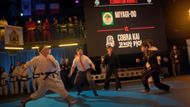Netflix’s Cobra Kai is packed with some epic fight scenes. The show mixes nostalgia with martial arts action, continuing the story of Daniel LaRusso and Johnny Lawrence while introducing a new generation of fighters.
Since the whole narrative revolves around martial arts, it leaves the audience wondering whether the karate featured in Cobra Kai is real. Well, the show does follow American karate quite closely, but the creators take some cinematic liberties in depicting various training and fight scenes.
To add authenticity to the show, some cast members had real martial arts backgrounds, while others had to learn the practice. Let’s take a closer look at how real the karate seen in Cobra Kai is.
Cobra Kai features real karate with some dramatic liberties

Cobra Kai blends real karate techniques with some drama. It does a pretty good job of showing what karate is like, even though it adds some over-the-top elements to make things more entertaining.
In real-life American dojos, students use equipment like punching bags and weights to build strength and improve their skills. The show includes these tools, making it feel realistic.
Martial arts vlogger Sensei Seth highlighted how the show compares to real-life American dojos in one of his YouTube videos. He said:
“American dojos usually like to think more about equipment and efficiency first when it comes to their training. The series showed weights, they had a back room, a section for squats and different isometric movements, all different sections for performance training for athletic sport.”
The heavy focus on kicks also makes sense because the karate style in Cobra Kai is influenced by Tang Soo Do, a Korean martial art similar to Taekwondo. Back in the 1980s, karate in the US started including more kicks because of Taekwondo’s influence, and this change is shown in the series.
Sparring, or practice fighting, is a big part of the show. In real life, sparring usually involves wearing protective gear, but the show skips this to make the fights look more dramatic. This no-gear style is similar to flashy demonstrations some schools do to impress people or attract students.
Johnny Lawrence’s struggles with running the dojo in the series also seem real. Being a great fighter does not mean you are great at running a business, and Johnny’s lack of marketing skills and rule-breaking ways depict this. Many real martial arts instructors deal with similar challenges.
That being said, Cobra Kai does take some creative liberties. For example, in real dojos, beginners usually get one-on-one lessons to learn the basics of the practice first. But in the show, new students often start with intense training or sparring right away.
The show also shows some characters who master difficult moves in a few weeks. In real life, these techniques take years of practice. For example, Xolo Maridueña, who plays the role of Miguel in the series, trained for months in martial arts, boxing, and yoga to get ready for his role.
Additionally, the high-stakes competition in the show, the Sekai Taikai, is also made up. It is described as the most important karate tournament in the world but is entirely fictional, just like the All-Valley Tournament in The Karate Kid. These events let the writers create their own rules and add drama to the story.
Hence, Cobra Kai gets many things right about karate but is not a perfect representation of the practice. While the show does not fully showcase the discipline and respect emphasized in real dojos, its fun and exciting look at martial arts culture makes it an entertaining watch.
Cobra Kai seasons 1 to 6 are streaming on Netflix.
